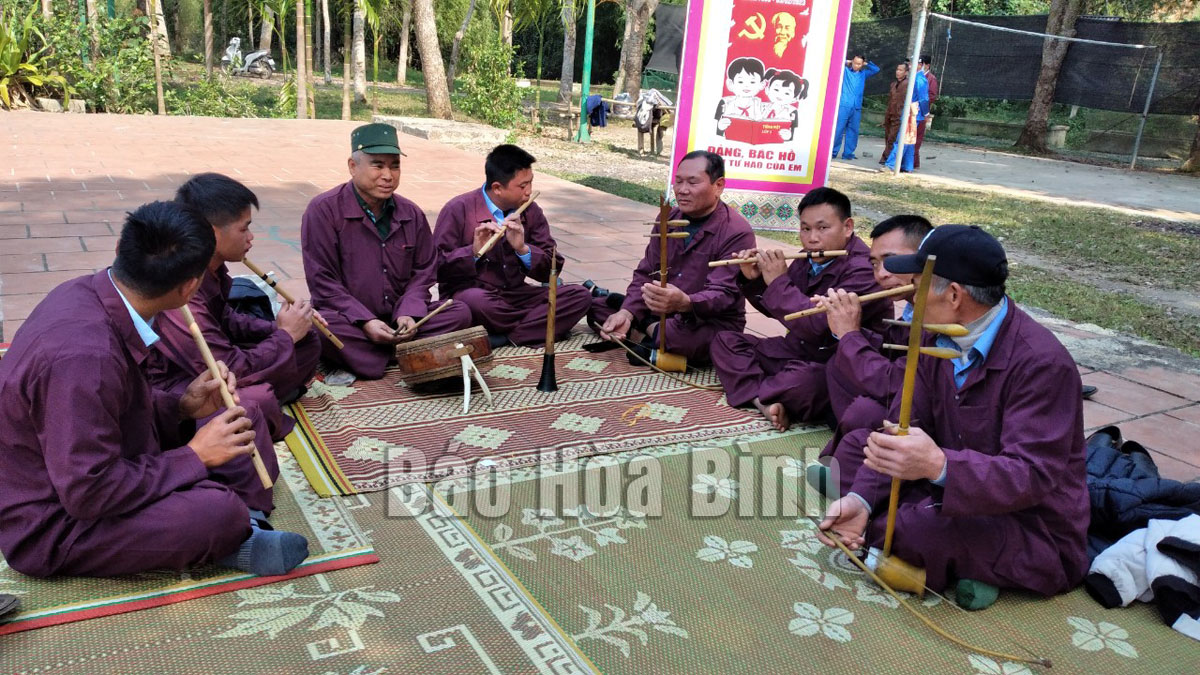
(HBO) - The gongs in Muong land resounded, delighting thousands of people present at the stadium of Tan Lac district’s Phong Phu commune on the morning of the eighth day of the first lunar month. The Muong gong performance by 500 artisans and actists from four major Muong regions of Bi, Vang, Thang and Dong was the highlight in the art programme to celebrate the Khai ha (going down to the field) festival of the Muong ethnic group in Hoa Binh province in 2023.

Artists in Phu Cuong
commune (Tan Lac) practice before entering the official competitions at Khai ha
(going down to the field) festival in 2023.
This year, the most important traditional festival, a
national intangible cultural heritage, of the Muong people in Hoa Binh was held
at the provincial level for the first time, attracting the participation of all
the four Muong regions. Many activities were held in honour of the unique
values of the Muong ethnic culture in general, and the group’s traditional
music in particular.
According to meritorious artist Bui Ngoc Thuan in Thu Phong
commune (Cao Phong), through the traditional musical genres, the soul of the
Muong ethnic group is expressed intact in contemporary life. like other Muong
regions, Muong Thang, his hometown, in recent years has actively preserved the
ethnic cultural identity with the determination to maintain and promote
traditional cultural values. Through many practical activities such as cultural
and artistic exchanges, organisation of inter-generational clubs, he said he
was pleased to see that the soul of the Muong ethnic culture has been preserved
and honoured. That is the solid spiritual foundation for generations of Hoa
Binh people to continue to build a new cultural life in their beautiful
homeland.
With an increasingly vibrant and widespread emulation movement aimed at building cultured residential areas and cultured families, Yen Thuy District has been making steady progress toward improving both the material and spiritual well-being of its people, while fostering a civilized, prosperous, beautiful, and progressive community.
Once lacking recreational spaces and community facilities, Residential Group 2 in Quynh Lam Ward (Hoa Binh City) has recently received attention for the construction of a new, spacious, and fully equipped cultural house. The project followed the model of state support combined with public contributions in both labor and funding.
The "All people unite to build cultural life" movement, which has been effectively integrated with Kim Boi district’s socio-economic development goals, is fostering a lively spirit of emulation across local residential areas, hamlets, villages, public agencies, and enterprises. In addition, through the initiative, traditional cultural values are being preserved and promoted, while community solidarity and mutual support in poverty reduction and economic development are being strengthened.
A working delegation of the Hoa Binh provincial People’s Committee led by its Permanent Vice Chairman Nguyen Van Toan on June 11 inspected the progress of a project to build the Mo Muong Cultural Heritage Conservation Space linked to tourism services in Hop Phong commune, Cao Phong district.
Born and growing in the heroic land of Muong Dong, Dinh Thi Kieu Dung, a resident in Bo town of Kim Boi district, in her childhood was nurtured by the sweet lullabies of her grandmother and mother. These melodies deeply imprinted on her soul, becoming an inseparable part of her love for her ethnic group's culture. For over 20 years, this love for her hometown has driven Dung to research, collect, and pass down the cultural values of the Muong people to future generations.
In the final days of May, the Ethnic Art Troupe of Hoa Binh Province organized performances to serve the people in remote, mountainous, and particularly disadvantaged areas within the province. These were not just ordinary artistic shows, but they were the meaningful journeys aimed at spreading cultural values, enhancing the spiritual life of the people and contributing to the preservation of ethnic minority cultural identities.



